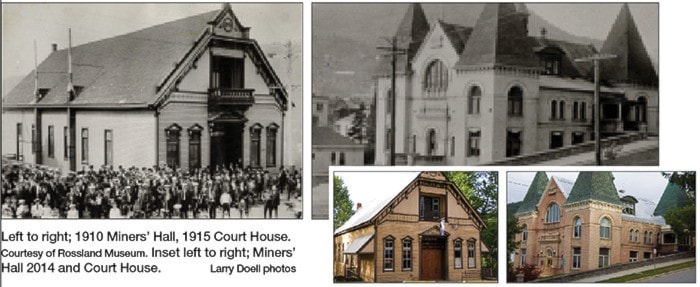Tara Howse
Rossland News
Sitting with Jackie Drysdale, Chair of the Rossland Heritage Commisison, and listening to her talk about the efforts the Heritage Commission has been up to in the last 5 years and the passion for the work that’s been done, is easy to hear.
Since 2009 when the Commission was formed, the group had been working on a number of projects, allowing for the preservation of heritage stories in town through conserving and creating awareness of significant buildings and sites.
Rossland actually has an incredibly dense stock of potential buildings, a volume that puts them in the same company as Victoria with both the Rossland Court House and the Rossland Miners Union Hall recognized as national historic sites.
Through a visual story board, the Heritage Commission is aiming to share the history of Rossland’s built environment. A key factor in designating an historic building is its significance to the community.
Each of the homes and buildings identified by the Commission must be more than simply “old” – age does not automatically mean a building, house, or site is deemed historic. The Commission must take the time to learn the history of a building or site and then determine the significance and impact it had (or continues to have) on Rossland.
The Commission follows the national standards and guidelines as set out by Canada’s Historic Places. Nominations are put forward once a particular place has been identified to have heritage value by considering the aesthetic, historic, scientific, cultural, social or spiritual importance or significance for past, present and future generations.
These standards guide in forming a statement of significance for each place which tells us why a particular place is important, explaining the heritage value. In essence, the Heritage Commission must ask of every potential place: What story does this tell?”
To be formally included on the national registry, the community must have plans for the maintenance and sustainable use of the place.
Recognizing the high cost and resources involved in maintaining and renovating some of the places in Rossland, the Commission opted to create a local registry wherein national guidelines are followed. Although not a legal registry, this local registry now acts as a tool in land-use planning discussions wherein the Commission submits recommended sites to be considered heritage sites for council to recognize and endorse.
With nearly 50 identified buildings and sites, the Commission continues to work on developing statements of significance and early histories of each of these places. They welcome any additional research or valid information that can assist in developing these.
Alongside the local Heritage Registry is a compilation of homes. Originally published in 1983, the Heritage Commission took it upon itself to update the Heritage Home Inventory project, a collection of houses built prior to 1930.
Available on the City of Rossland’s website, a 2014 Heritage Home Book documents the 80-plus homes on the inventory which include descriptions, architecture style, alterations or restorations that have been completed and an early history on each of these homes.
What else is left for the Heritage Commission to do? Lots, apparently. With only a handful of the local registry places having completed statements of significance, completing the research and finalizing these statements are a priority.
Secondly, the Commission wants to work regionally and build the relationships with other museums and historical societies in order to better expand the knowledge and research in this area.
“The Columbia Cemetery is an excellent example of needing to work with groups regionally: individuals and families are calling and visiting the area seeking information about their family histories,” Jackie adding, “There is an interest in history. People want to know their roots.”
Although some in town may view buildings as merely bricks, mortar and simple functions of necessity, it is the unique aspects of the architecture and style that lend to Rossland’s charm. The Heritage Commission contributes to limiting the cookie-cutter, big-box style buildings and homes that are proliferate in so many Canadian communities and it is through their research efforts that we have such beautiful historic places to share.
For more information on helping the Commission’s efforts, to nominate a site, or if you have any information on identified sites, please contact Jackie Drysdale at 362-3323 or jackie_drysdale@telus.net.
